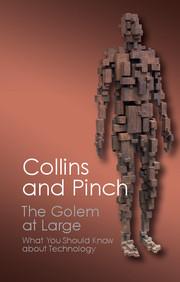Book contents
- Frontmatter
- Dedication
- Contents
- Preface and acknowledgements
- Introduction: the technological golem
- 1 A clean kill?: the role of Patriot in the Gulf War
- 2 The naked launch: assigning blame for the Challenger explosion
- 3 Crash!: nuclear fuel flasks and anti-misting kerosene on trial
- 4 The world according to Gold: disputes about the origins of oil
- 5 Tidings of comfort and joy: Seven Wise Men and the science of economics
- 6 The science of the lambs: Chernobyl and the Cumbrian sheepfarmers
- 7 ACTing UP: AIDS cures and lay expertise
- Conclusion: the golem goes to work
- References and further reading
- Index
2 - The naked launch: assigning blame for the Challenger explosion
Published online by Cambridge University Press: 05 June 2014
- Frontmatter
- Dedication
- Contents
- Preface and acknowledgements
- Introduction: the technological golem
- 1 A clean kill?: the role of Patriot in the Gulf War
- 2 The naked launch: assigning blame for the Challenger explosion
- 3 Crash!: nuclear fuel flasks and anti-misting kerosene on trial
- 4 The world according to Gold: disputes about the origins of oil
- 5 Tidings of comfort and joy: Seven Wise Men and the science of economics
- 6 The science of the lambs: Chernobyl and the Cumbrian sheepfarmers
- 7 ACTing UP: AIDS cures and lay expertise
- Conclusion: the golem goes to work
- References and further reading
- Index
Summary
We always remember where we were when we first heard about a momentous event. Those over forty-five years old know what they were doing when they heard that John F. Kennedy had been assassinated. Similarly, anyone who was watching television remembers where they were at 11:38 a.m. Eastern Standard Time on 28 January, 1986 when the Space Shuttle Challenger exploded. The billowing cloud of white smoke laced with twirling loops made by the careering Solid Rocket Boosters proclaimed the death of seven astronauts and the end of the space programmme's ‘can do’ infallibility.
Unlike the inconclusive Warren Commission that inquired into Kennedy's death, the Presidential Commission chaired by William Rogers soon distributed blame. There was no ambivalence in their report. The cause of the accident was a circular seal made of rubber known as an O-ring. The Challenger's Solid Rocket Boosters were made in segments, and the O-rings sealed the gap between them. A seal failed and the escaping exhaust gas became a blow torch which burned through a strut and started a sequence of events which led to the disaster.
- Type
- Chapter
- Information
- The Golem at LargeWhat You Should Know about Technology, pp. 40 - 75Publisher: Cambridge University PressPrint publication year: 2014

